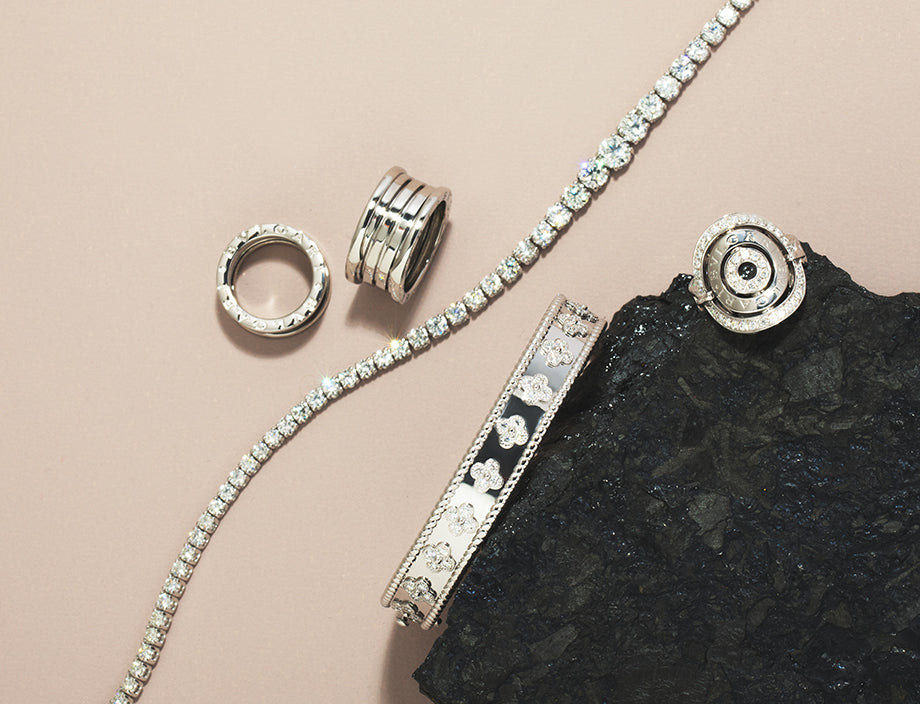Get answers to the following questions:
- How are diamonds formed
- Other ways that diamonds are formed
- How does diamond formation affect colour
- How does diamond formation affect clarity
- How to sell a diamond
How Are Diamonds Formed?
Naturally occurring diamonds are formed over millions of years deep within the Earths mantle over billions of years, as a result of heat and pressure from the Earths gravity.
- Diamonds originate from carbon that became trapped in the upper or lower mantle during the creation of the Earth.
- For diamonds to form, they require immense amounts of both heat and pressure. The Earths mantle has extremely high temperatures and pressure, equivalent to miles of rock stacked on top of each other. This heat and pressure combines to change the composition of graphite (a form of carbon) on an atomic level.
- The composition of the carbon changes from a hexagonal sheet to a triangular shape, resulting in the formation of diamonds.
- High levels of magnesium and carbon in conjunction with the high pressure in the mantle lead to intense eruptions. Diamonds are brought to the surface of the Earth during these eruptions through kimberlite pipes.
- Kimberlite pipes create kimberlite sites on the surface of the Earth. These kimberlite sites are pockets on the surface of the Earth where diamonds can be found and then mined.
Other Ways That Diamonds Are Formed
1. Collisions Between The Earth And Asteroids
Diamonds can form when an asteroid collides with the Earth. However these are usually low quality gems that do not meet standards for commercial jewellery use, but are still strong enough to be used for cutting or manufacturing purposes.
2. Meteorites
Very tiny diamonds can be found inside of meteorites. These diamonds are only a few nanometers in diameter as they form from traces of carbon. These traces of carbon are left over from the formation of the universe or from pieces of planets that no longer exist. While the carbon traces are tiny, they are still substantial enough to be molded into diamonds through intense pressure and heat.
3. Synthetic Diamonds
The creation of lab grown diamonds has increased exponentially in recent years. The first synthetic diamond was produced in 1954 in the General Electric Laboratory.
High Pressure High Temperature (HPHT) replicates the way diamonds are naturally formed, by heating the diamond seeds above their boiling point but without vaporisation and applying heavy pressure to them.
In 2019, the more common way to produce synthetic diamonds is with Chemical Vapor Deposition (CVD). Chemical Vapor Deposition occurs when gases that are often diluted in carrier gases enter the reaction. These gases touch a heated substance and then react and form a solid.
Chemical Vapor Deposition takes approximately 28 days and various colours can be produced such as white, yellow, brown, blue, green, and orange. Synthetic diamonds tend to be cleaner than natural diamonds because they do not have the naturally occurring inclusions that natural diamonds have.
However, synthetic diamonds are not flawless; these diamonds still can have inclusions and blemishes. The rise in demand for synthetic diamonds is a direct result of the ethical issues and ecological damages that diamond mining causes. However there are serious concerns over the amount of energy required to create these synthetic stones, bringing into question their green credentials. Recycled diamonds therefore become the more environmentally friendly way to shop, reducing the demand for both mining and lab grown diamonds.
How Does Diamond Formation Affect Colour?
The formation of the diamond has a direct impact on the colour of the stone created. Below are some examples of the way formation affects the colour of the diamond:
- Yellow diamonds: The presence of nitrogen can create yellow diamonds.
- Blue diamonds: The presence of boron can create blue diamonds.
- Black diamonds: Small inclusions of graphite and iron clusters can create black diamonds.
- Green diamonds: The presence of radioactive materials such as uranium or thorium can create green diamonds.
- Purple diamonds: After the diamonds are formed, plastic deformation while the diamond is traveling from the earths mantle to the surface can create purple diamonds.
- Pink diamonds: Changes to the electron structure can create pink diamonds.
- Red diamonds: It is believed that defects in the diamonds crystal lattice can create red diamonds.
How Does Diamond Formation Affect Clarity Grade?
The formation of the diamond can also impact its clarity grade. The clarity grade is the extent to which inclusions (flaws within the stone) and blemishes (scratches and nicks on a diamonds surface) affect its appearance.
These range from F (flawless) to I3 (eye visible inclusions). The clarity grade is based on the presence of inclusions and blemishes as well as the position of the inclusions and/or blemishes. During formation, particles can get trapped within the stone or damage the stone as it travels to the Earths surface.
How To Sell A Diamond?
As a leading buyer of diamonds and diamond jewellery, at myGemma we work with hundreds of customers on a daily basis from around the world.
Complete our online form today to receive your bespoke price quote from our diamond experts.
Our professional and streamlined process is entirely secure and can take as little as 24 hours, with no fees or commissions deducted from your final price. Sell diamonds by appointment in the UK, New York, Tokyo or Hong Kong, or sell online with our free and fully insured shipping service. Read our hundreds of customers reviews here.































